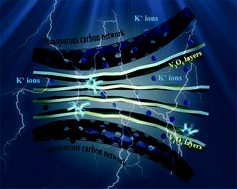Ultra-high rate capability of nanoporous carbon network@V2O5 sub-micron brick composite as a novel cathode material for asymmetric supercapacitors†
Abstract
A green biomass-derived nanoporous carbon network (NCN) has been prepared and integrated with V2O5 sub-micron bricks (SMBs). The large surface area and high pore volume of the NCN can not only provide abundant sites for electrochemical reactions but also stabilize the structure of the V2O5 SMBs. The NCN@V2O5 SMB composite, acting as a novel cathode material, delivers a high areal capacitance of 786 mF cm−2 at 0.2 mA cm−2 and superior cycling stability with 89.5% capacitance retention after 5000 cycles. Besides, the electrode achieves an ultra-high rate capability (82% capacitance retention as the current density increases from 0.2 to 5 mA cm−2) since the contribution from the non-diffusion-controlled process is estimated to be as high as 95.5%–98.5% according to the kinetic analysis. Furthermore, the micropores are more favorable than the mesopores at lower current densities (0.2–2 mA cm−2), while the contribution of the external surface area becomes more significant for current densities higher than 2 mA cm−2. Moreover, an asymmetric supercapacitor assembled using this cathode and the NCN anode shows superior electrochemical properties, such as wide operating voltage, long cycle life and large energy density (72.2 μW h cm−2). Their excellent electrochemical features and good eco-friendliness confirm the potential of the NCN@V2O5 SMBs for use as supercapacitors.



 Please wait while we load your content...
Please wait while we load your content...